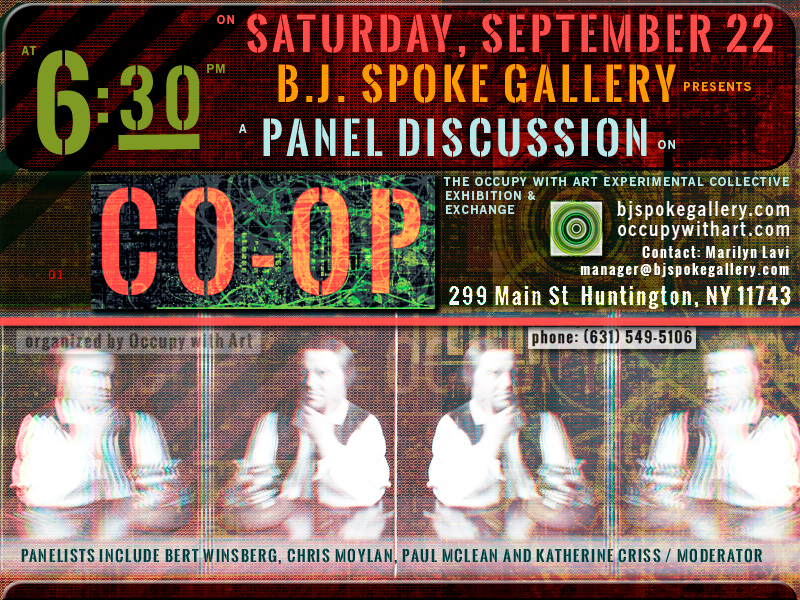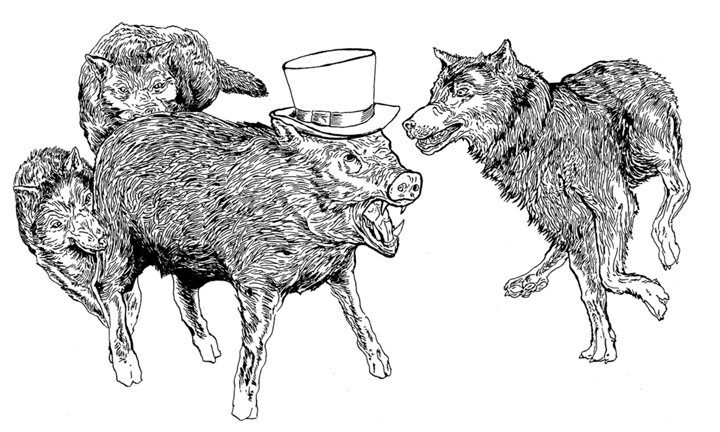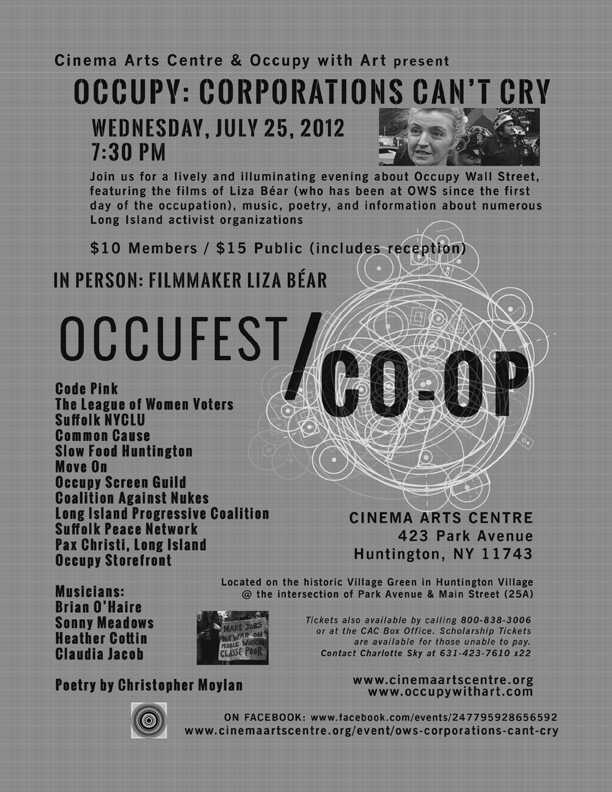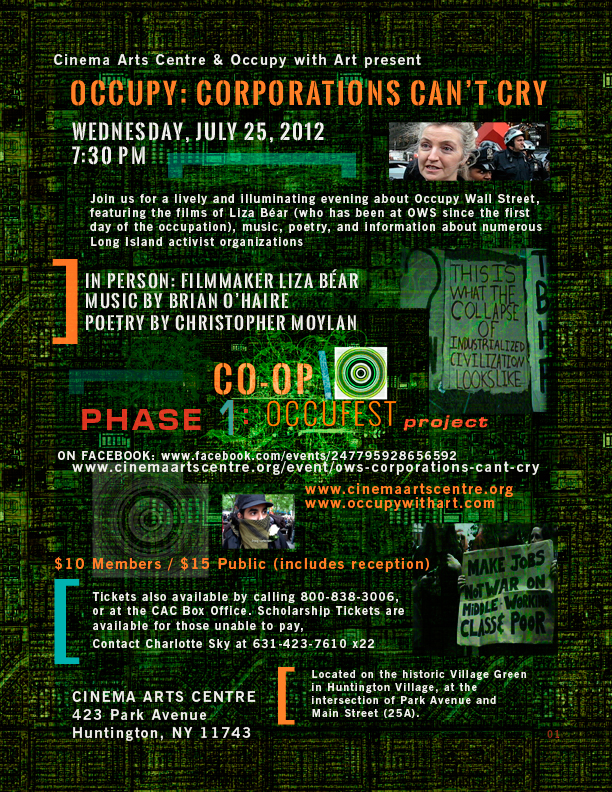The Occupy with Art blog provides updates on projects in progress, opinion articles about art-related issues and OWS, useful tools built by artists for the movement, new features on the website, and requests for assistance. To submit a post, contact us at occupationalartschool(at)gmail(dot)com .
Entries in co-op (16)
CO-OP at b.j. spoke Gallery [Opening Reception, 9/8 report-back]
 Wednesday, September 12, 2012 at 12:17PM
Wednesday, September 12, 2012 at 12:17PM Photo Credit: Katherine Criss
Saturday, September 8 marked the opening of CO-OP in Huntington, Long Island at the venerable b.j. spoke gallery. CO-OP is the Occupy with Art experimental collective project to integrate the 99% art economy with the cooperative food economy. Many of the bj spoke artists in the front and back galleries displayed powerful political artworks for the exhibit. True to Occupy form, we started the evening with street protest, thanks to Occupy Huntington. The good people of Occupy Storefront contributed a couple of last minute entries to our exhibition component, which added a lot of color to the array. The food spread and beverages were terrific, shared by the bj spoke artist community, the OwA participants (Chris baked a great pie and tarts) and our generous sponsors, Blind Bat Brewery. We had a terrific crowd for the reception, starting before the door opened at 6pm and continuing well into the evening. At 7pm, I made a performance art, throwing darts at my portrait of Mayor Bloomberg. It was a hit (actually all of them were)! Then, Chris and I gave brief talks about the project and Occupy with Art. Thank you to all who contributed to what was a wonderful evening of sharing art, convivials + passionate resistance and/or creative insistence. Special thanks goes to Marilyn Lavi, bj spoke director, Katherine Criss, and the bjs crews and committees who were vital in the actualization of this worthy collaborative project. Artist-owned and operated co-operative businesses are essential in a healthy arts ecology, and bj spoke is a great example and demonstration of that fact! - PJM
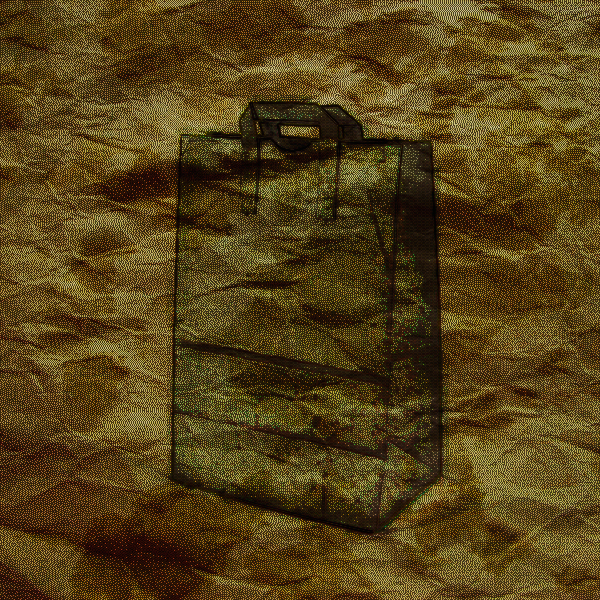
CO-OP at b.j. spoke Gallery [TONIGHT!]
 Saturday, September 8, 2012 at 01:03PM
Saturday, September 8, 2012 at 01:03PM 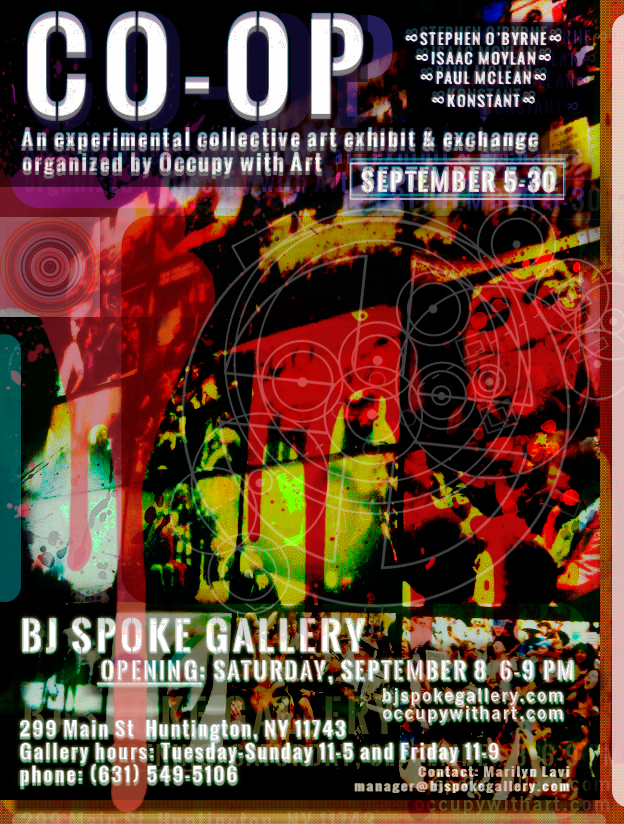
Occupy with Art and B.J. Spoke Gallery in Huntington, Long Island are pleased to announce the launch of CO-OP, an experimental collective art exhibit and exchange, on view from September 5-30, 2012. A reception will be held at the gallery on Saturday, September 8, from 6-8 PM. CO-OP will feature an array of OWS photos by Steve O'Byrne, works on paper by Konstant and Isaac Moylan, and 4D animations, paintings and multimedia pieces by Paul McLean. CO-OP will introduce a model gift-barter of art for food, prototyping the direct integration of the local art and cooperative food networks.
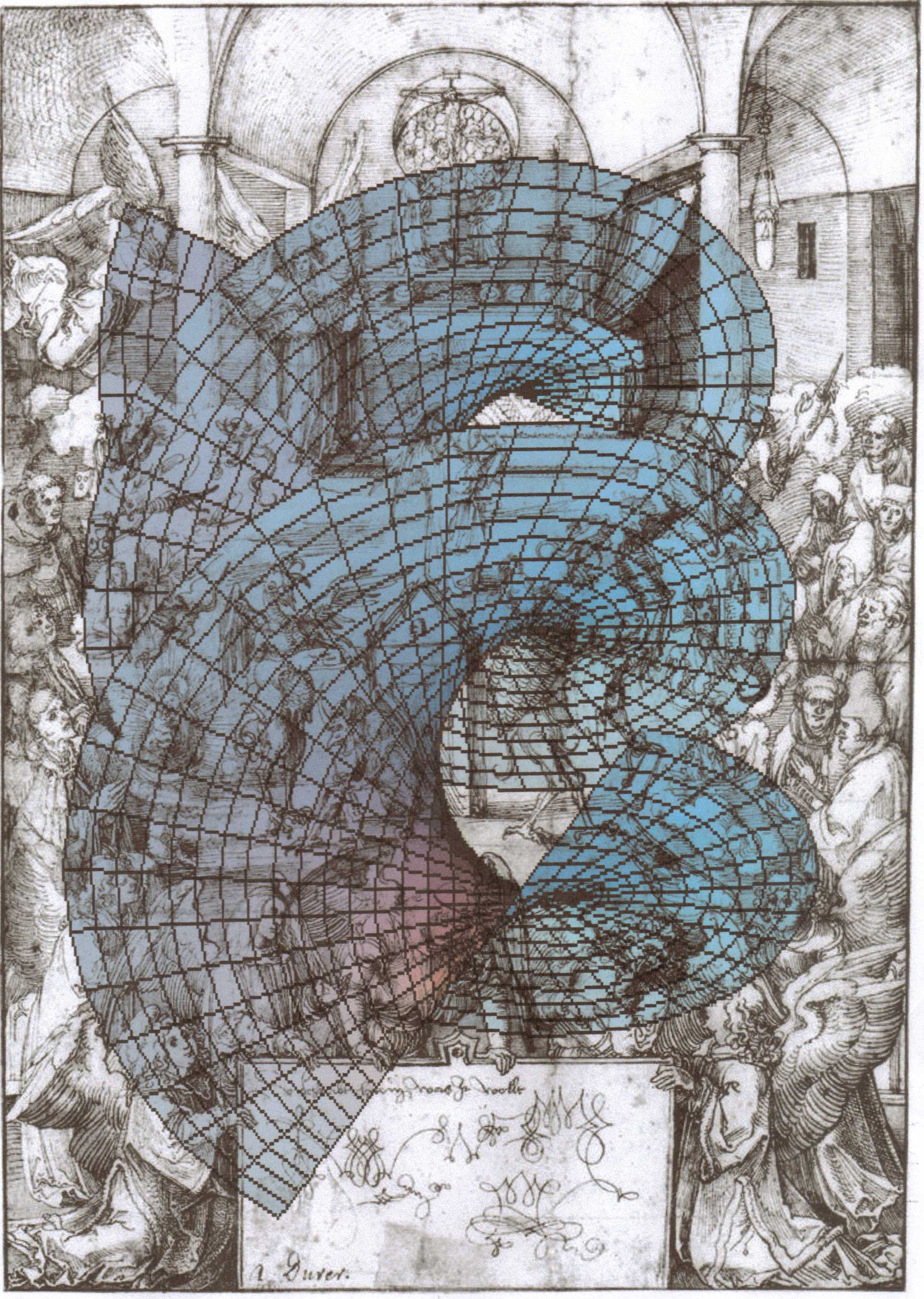 Konstant
Konstant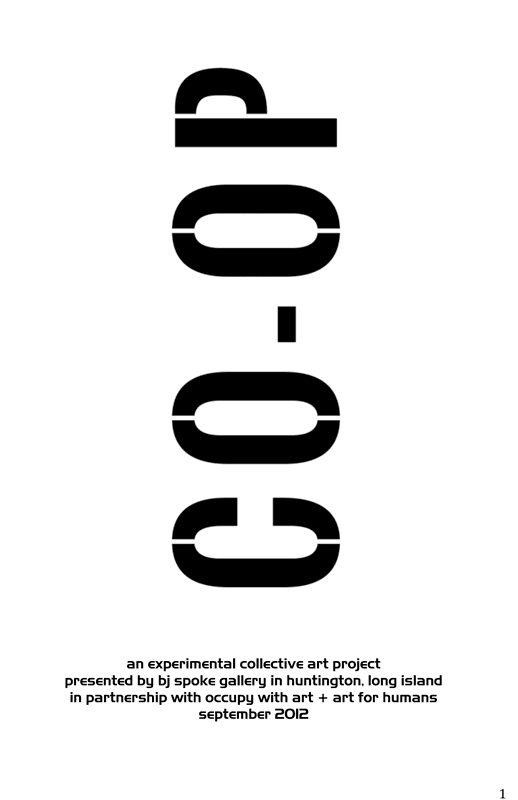
- Download the CO-OP book HERE.
- Download the CO-OP stencil HERE.
- See the CO-OP photoset HERE.
- Paul McLean's new essay for the Brooklyn Rail, "WTF America!"
- Steve O'Byrne's OWS photos at Flickr.
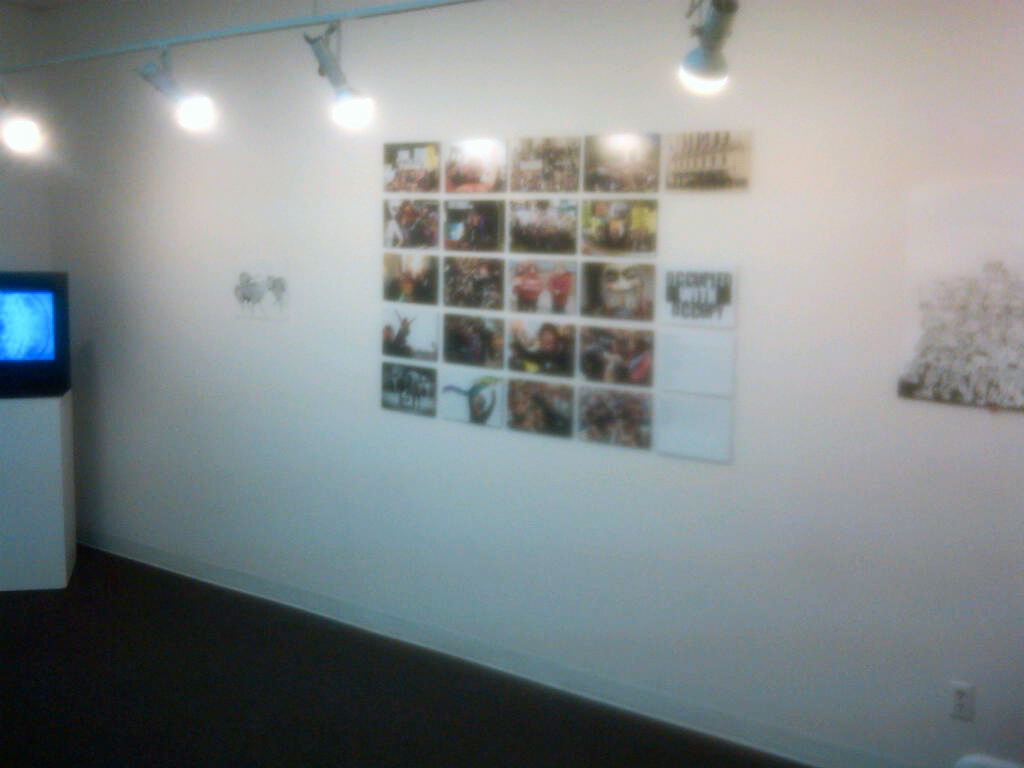 CO-OP installation view at bj spoke gallery.[EXHIBIT CONCEPT, NARRATIVE and DESCRIPTION]
CO-OP installation view at bj spoke gallery.[EXHIBIT CONCEPT, NARRATIVE and DESCRIPTION]
CO-OP/Occuburbs/Occufest began in December 2011 as an Occupy with Art (OwA) initiative to bridge the apparent divide between Occupy Wall Street and artist-activists living in the suburbs of New York City - specifically, those who make Long Island their home. OwA co-organizers Paul McLean and Christopher Moylan, a Long Island-based educator, artist, poet and Occupier, discussed a range of measures they hoped might activate and unite Occupy with those sympathetic to the movement in Long Island, measures that included community-building cultural events and art exhibitions, in addition to mobilizing or organizing efforts. In so doing McLean and Moylan hoped to model innovative programs for sustainable, alternative art economies for the 99%, and to inspire those who engaged in activism in the past several decades to get involved with OWS actions, now.
Drawing from Moylan's experience in co-operative food networks, the co-organizers developed the CO-OP concept into an exhibition with an art and food exchange component. Through the CO-OP exchange, OwA is developing a simple template for in-kind or barter-based markets that will help artists become more integrated in communities that lack accessible or available retail infrastructure for affordable art. After a search and inquiry phase, McLean and Moylan, found great partner organizations in Huntington - The Cinema Arts Centre, which hosted an OwA screening program on July 25th featuring the films of Liza Bear, and B.J. Spoke, a member-supported gallery with deep roots in Long Island, dating to the 70s.
Moylan and McLean have written essays to platform the issues underpinning CO-OP, which have either been published in The Brooklyn Rail or the Occupy with Art blog. These include Moylan's CO-OP/Occuburbs/Occufest series, McLean's "ENOUGH [BASTA]!" and, more generally, McLean's "Soul of Occupy" sequence, which maps the sometimes (for the author) discomfiting parameters and expectations for art situated in the OWS protest movement, in its initial anarchic emergent state.
[ABOUT OCCUPY WITH ART]
The CO-OP production builds on OwA programs and initiatives, such as "Occupy Printed Matter," OwA's collaboration with Yoko Ono entitled "Wish Tree for Zuccotti Park," the Spatial Occupation at Hyperallergic, "Wall Street to Main Street," "Low Lives: Occupy!" and the soon-to-open Occupational Art School Node #1 at Bat Haus in Bushwick, Brooklyn, NYC. Occupy with Art was founded in late September as Occupennial, and until recently existed as an affinity group for the Arts & Culture Working Group of the New York City General Assembly for Occupy Wall Street. Over the past ten months, OwA has operated in constant transition, serving initially as a nexus for communications and documentation of OWS-related arts and culture, then shifting into production and program development. Over its brief life span OwA has generated many opportunities for Occupy artists to share ideas and work, facilitated important discourse on the disposition of art and artists in the Occupation, and presented diverse programming exploring a spectrum of meaningful creative action.
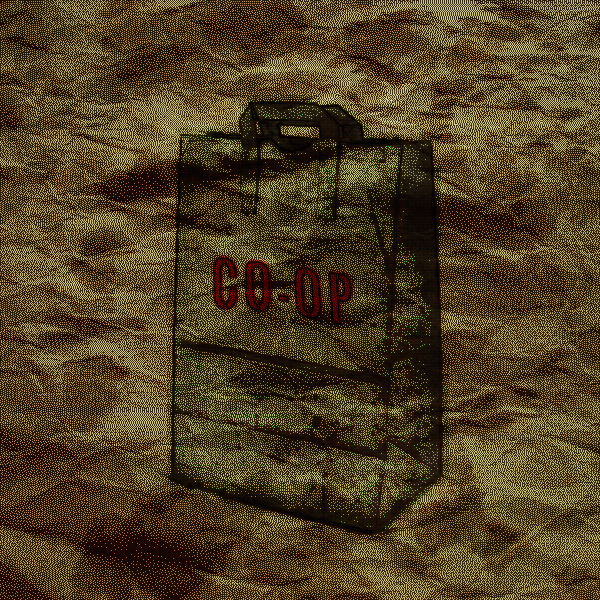
 BJ Spoke Gallery,
BJ Spoke Gallery,  co-op,
co-op,  occuburbs,
occuburbs,  occufest in
occufest in  exchanges,
exchanges,  exhibition,
exhibition,  games
games [CO-OP]: @b.j. spoke Gallery [Trans-animation]
 Sunday, September 2, 2012 at 12:20AM
Sunday, September 2, 2012 at 12:20AM Trans-animation for window display at CO-OP, an Occupy with Art experimental collective project at bj spoke gallery [Sept 5-30, opening reception Sat Sept 8, 6-9pm] in Huntington, LI.
Moving images by Paul McLean. Special thanks to Cody Sullivan, Isaac Moylan, Konstant and Michael Barron. Also, gratitude to Novads of Magic Mtn, Direct Action Flaneurs, Occupational Art School, Living Gallery, Co-Lab Projects (Austin) [+]
 BJ Spoke Gallery,
BJ Spoke Gallery,  Paul McLean,
Paul McLean,  co-op in
co-op in  animation
animation New OwA ads for the September issue of Brooklyn Rail
 Monday, August 27, 2012 at 07:44AM
Monday, August 27, 2012 at 07:44AM  Brooklyn Rail ad for September
Brooklyn Rail ad for September
 Brooklyn Rail ad for September
Brooklyn Rail ad for September
 Brooklyn Rail,
Brooklyn Rail,  ads,
ads,  co-op,
co-op,  occupational art school,
occupational art school,  occupy with art in
occupy with art in  graphics,
graphics,  identity
identity [CO-OP]: @b.j. spoke Gallery [BETA][Draft]
 Saturday, August 11, 2012 at 04:11PM
Saturday, August 11, 2012 at 04:11PM 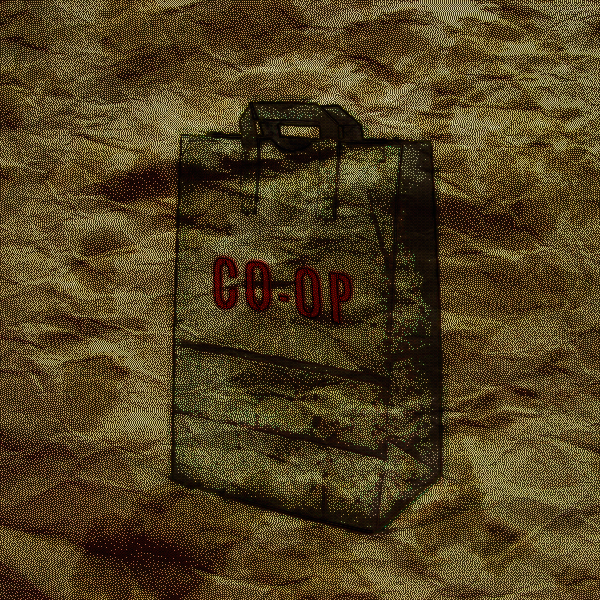 Image by Paul McLeanCO-OP at b.j. spoke gallery
Image by Paul McLeanCO-OP at b.j. spoke gallery
by Paul McLean
Co-organizer, Occupy with Art
1
A half-block from the intersection of Wall Street and Main Street in Huntington, Long Island, you'll find b.j. spoke gallery. Here's its history, from the gallery website:
>>
b. j. spoke gallery, incorporated and not-for-profit, is an artist-run gallery of professional artists with a broad diversification of styles and media.
April 1990 marked the inaugural show of two newly merged Long Island cooperative galleries, Northport Galleries and B. J. Spoke Gallery.
Spoke Gallery began in 1976 at a Port Washington site and later moved to neighboring Sea Cliff, New York. In 1980 Northport Galleries was established in Northport and seven years later moved to Huntington, NY.
Because of the ongoing friendship of the two galleries, the idea of a merger was enthusiastically accepted in 1990 by both memberships.
<<
2
b.j. spoke is divided into three areas. Occupy with Art in September of 2012 will present CO-OP in b.j. spokes' central gallery. Our location within the brackets of the other two galleries, which will show member artists, reflects OwA's desire to support the mission of this important Long Island art organization, which has long advocated partnership between the artist and public as an "essential relationship."
Since the first exhibit OwA facilitated, "Occupy Printed Matter," in 2011, Occupy with Art has sought to establish bridges between Occupy Wall Street's artist activism and the artist activism that has emerged since the 70s in New York, and around the world. In "Wall Street to Main Street," for example, we partnered with renowned curator Geno Rodriquez, founder and former director of the Alternative Museum. OwA worked with Yoko Ono to manifest her project in support of OWS, "Wish Tree for Zuccotti Park." Now, with CO-OP, we are calling attention to the important contributions of artist-operated non-profits like b.j. spoke in providing important venues for underserved artist communities in areas outside major retail art markets. b.j. spoke and galleries like it have done great service to the 99% art world and the people for whom art is more than a luxury item or vehicle for speculation.
3
CO-OP is a dimensional art project. CO-OP is first and foremost a small collective show, an exhibit, as such. It is a template or model for occupational art practice, demonstrating one way that Occupy artists can partner with pre-existing arts organizations as an expression of solidarity. among 99% artists and our communities. CO-OP is a conceptual project, in which we will link co-operative food networks and artists within the medium of gift exchange for mutual aid and benefits.
4
Conceptual art typically requires an explanation for the viewer to engage the artwork or process fully. Concept, or idea art, is often meant to start conversations. OWS, which has started or re-started many important conversations, has itself been described in terms of art. CO-OP is meant to start conversations about sustainable art and artist economies for the 99%. OwA co-organizers are drawing on the successful history of co-operative food networks, as inspiration for propositions about new methods of exchange for art.
To summarize what has been a discussion spanning many months, OwA will partner with the Huntington food co-op (OwA co-organizer and Huntington resident Chris Moylan is one of the owners) to intertwine the exchange of art for co-op members, with the exchange of food for artists (or money, as a default or swap). Our art for food exchange, in this initial attempt, is rudimentary: the values are based on 1 to 1 ratios. An artwork valued at $20 can be exchanged for $20 worth of food. Huntington co-op members will be invited to select art and the artists will select food items for straight barter.
We will consider variations on the exchange (enthusiastically). The paper bags installed in the space with the art work are included primarily as symbols and signs of our micro-economy. CO-OP permits contemporary art to enter the consumer portable sector of the cultural economy, for which the brown paper bag has long been a staple. However, you'll see that our shopping bags are not exactly like those branded types a shopper fills with goods in SOHO, for example.
Gallery visitors are welcome to purchase art exhibited by CO-OP artists at full retail prices. b.j. spoke artists' work will not be included in this iteration of CO-OP, which is being conducted as a test of the process, essentially. CO-OP is also meant to raise awareness of local alternatives to the global art markets of Chelsea, for example, or the international art fair circuits.
We hope you enjoy CO-OP. Please don't hesitate to contact us with questions or feedback.
artforhumans [at] gmail [dot] com
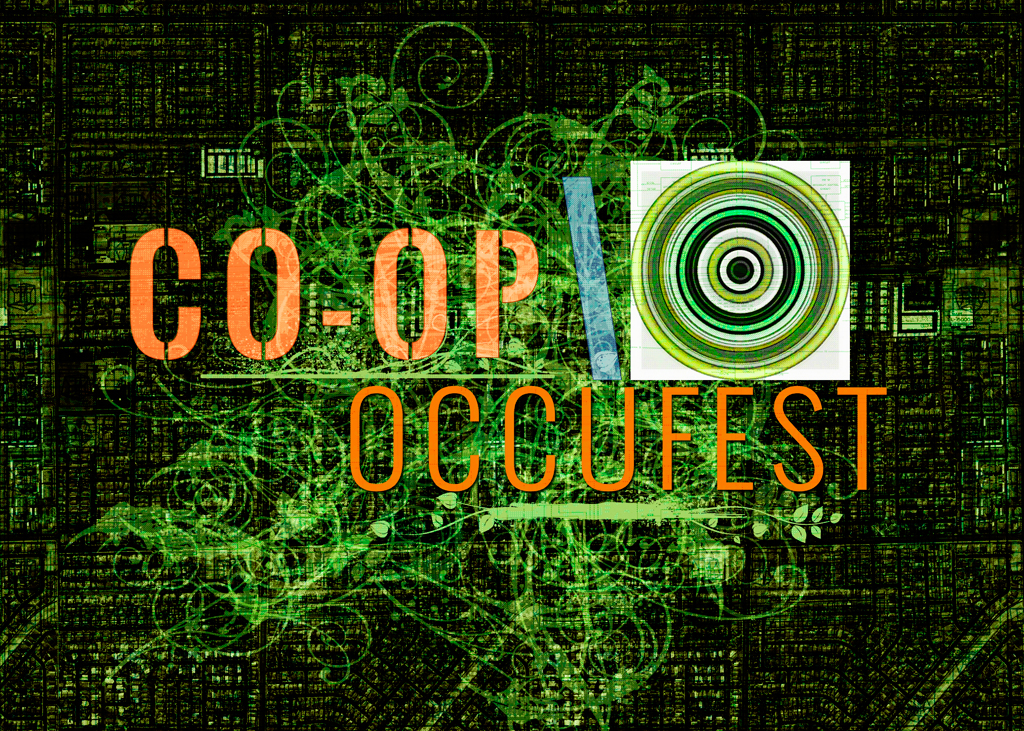
[CO-OP]: The Occupied Artist [BETA][Draft]
 Saturday, August 11, 2012 at 02:18PM
Saturday, August 11, 2012 at 02:18PM  American Artist by Paul McLean [48" x 36" mixed media on canvas 2007]The Occupied Artist*
American Artist by Paul McLean [48" x 36" mixed media on canvas 2007]The Occupied Artist*
By Christopher Moylan
1. Cultural Citizenship
The Occupied Artist is engaged in carving out a space of creative detachment from conventional social structures without necessarily ceding the material advantages of middle class life, so far as it is possible for an artist to acquire a middle class life. In effect, the Occupied Artist is a citizen of two domains: the ordinary world of late capitalism, globalization, the two-party system, etc., and a cultural milieu of Occupied and other non-capitalist arrangements of actual and virtual resources designed to provide some relief from the limitations of corporate discourse. The artist pioneers affiliations and community structures that encourage non-commercial, non-judgmental, supportive and welcoming approaches to creative exploration. Magic Mountain, Occupy with Art, Hyperallergenic, Poet Activist Community Extension, The Agit-Truth Collective: collaborative communities have proliferated in recent years, often bringing in artists of different media. The groups come and go; they are not intended to be permanent. The determination to grow another cultural milieu is permanent, however, and growing.
Such structures develop parallel to the usual forms of social engagement and not, so far as is practical, in conflict with them. Everyone has to make a living, and so long as corporate America continues to control our political and financial systems there is no contradiction in maintaining some balance of conventional and alternative ways of life. Nonetheless, the eventual goal is clear: to leave the world of rigged competition, financial decadence and political and not look back.
2. Development of an Alternative Art Economy
The Occupied Artist is part of an economic vanguard engaged in developing and applying an art economy from the structures of the so-called art world: white cube galleries; international art fairs; rich collectors; art media and fashion. In this world, money circulates among collectors, journals, advertising agencies, and artists, not to mention the low paid writers and support staff that keep the system in operation. It would be simplistic to claim that the art world is about money, but money is certainly very important. The role of the public in all this is negligible: mainly, supporting economies at several removes from the art world in the form of off the rack fashion and secondary businesses (restaurants and bars in gallery districts, art publications) and providing numbers at receptions and the like to generate buzz. Their opinions and their market force are dismissed; they, we, really don’t matter. The Occupied Artist explores ways to do the reverse: include the %99, marginalize the billionaire collectors, develop monetized and non-monetized forms of art support, create new configurations and dimensions for art exhibition, and nurture forms of discourse and cultural exchange that work within and for the community, however that community is defined—it could an online community, a neighborhood, a group affiliated with Occupy. Sometimes acquisition of given work will involve barter, labor exchange, work in kind, or co-op transactions. Sometimes there will be no need for a transaction, as in work placed on public walls or billboards, or inscribed on cans or boxes in a grocery store and left just to surprise people… Money is necessary of course: money for rent, utilities, phones, supplies… If you have some money, please donate (really, please donate). If you don’t want to donate, come to a rent party and drop a few dollars in the jar at the door. There are all kinds of ways to raise money…Art work in this alternative economy can be rigorous and challenging or fun or silly, but it will not be extremely, scarily expensive, unless the community really wants it to be.
3. Spatial and Dimensional De-Limitation
The Occupied Artist resists the market considerations that restrict exhibition to certain spaces and the financial and logistical obligations that come with them. Art fairs, traditional galleries, auctions and private sales contain art and artist in a spatial and economic matrix, the matrix of global capitalism. Virtual spaces, squats, occupations, fugitive exhibitions, and communal organizations break out of that market and spatial limitation. They appear in places the traditional art world shuns: poor neighborhoods, uncool neighborhoods, bodegas, farmhouses, barns…By doing so, they encourage people, all kinds of people, to take part, often as participants in the making of a piece. None of this is easy, although it can seem like a fugitive show in an old gas station or someone’s apartment just happens spontaneously. Quite the opposite; without the usual supports of financing and media drawing power, it takes a lot of planning, networking and organizing to move within this de-limited art world.
4. Humbly Occupied
Who wove the Bayeux Tapestry? Who turned and painted the urn that inspired Keats to write his ode? Who made most of the Native American art in museum collections around the country? In another world, the world envisioned by Occupy artists, it would be a simple matter to give up any prospect of celebrity for the chance to help weave something as wonderful as the Bayeux Tapestry. The Occupied art world would have no place for an Andy Warhol, as Andy Warhol, much as any Occupied artist admires him and values his critique of the postmodern image world. The Occupied artist is a revolutionary, not a celebrity. Attention, if it comes, is just a peripheral distraction. People have lost their homes, their jobs, and their pride. The climate is shifting alarmingly, unions are being outlawed, women assaulted in the media, anti-Gay bigotry celebrated in fast food chains and pulpits, young people impaled by college loans, banks and giant corporations are raping our constitution and demeaning our elected officials by paying for their votes. There is work to do. Cultural workers, Occupied artists, will do their part.
*NOTE: The impetus for this essay was a discussion with members of b.j. spoke gallery, during which the questions emerged (& this is somewhat simplifying): "What is an Occupy artist; what is Occupy art?" I would suggest that Chris has made a great beginning here, and that it would be great and important, should others continue this discussion, and add their ideas on the subject. - PJM
 Occupied artist,
Occupied artist,  chris moylan,
chris moylan,  co-op in
co-op in  art,
art,  artists,
artists,  occupations
occupations CO-OP at B.J. Spoke Gallery [Selected Images]
 Friday, August 3, 2012 at 11:21PM
Friday, August 3, 2012 at 11:21PM 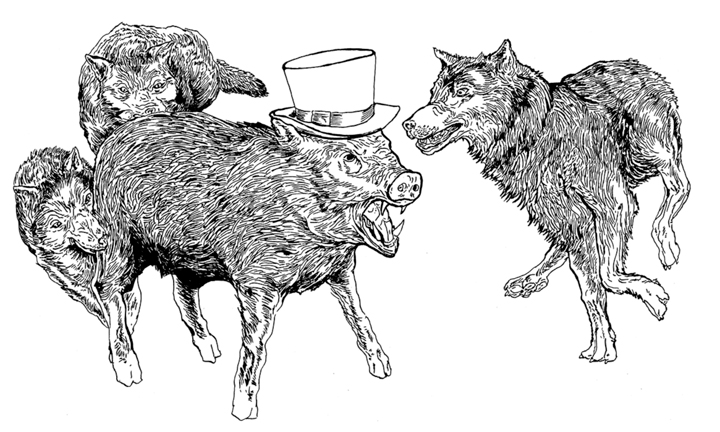 Isaac Moylan, "Wolves Bite Pig"
Isaac Moylan, "Wolves Bite Pig"
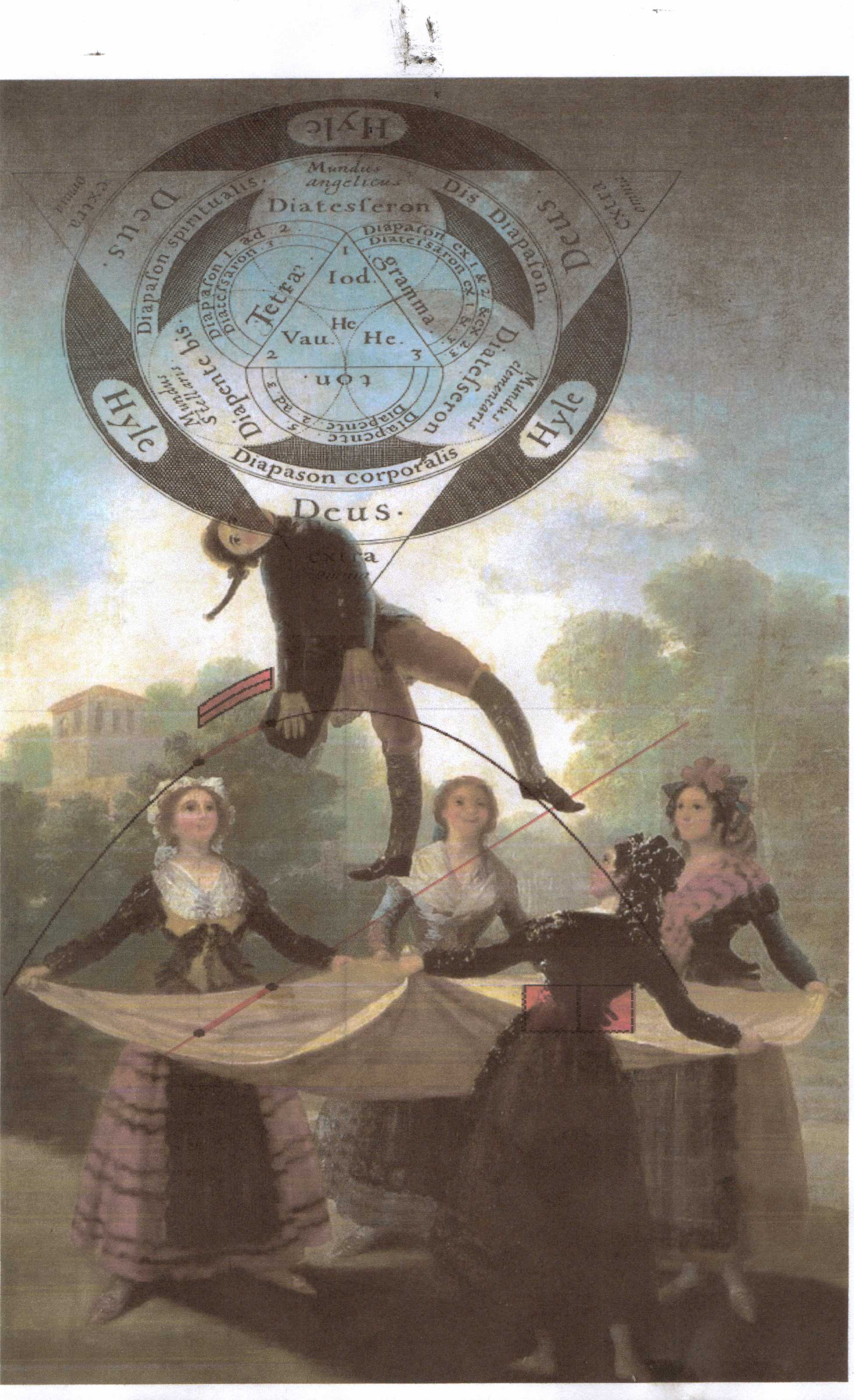 Konstant, "UNTITLED"
Konstant, "UNTITLED"
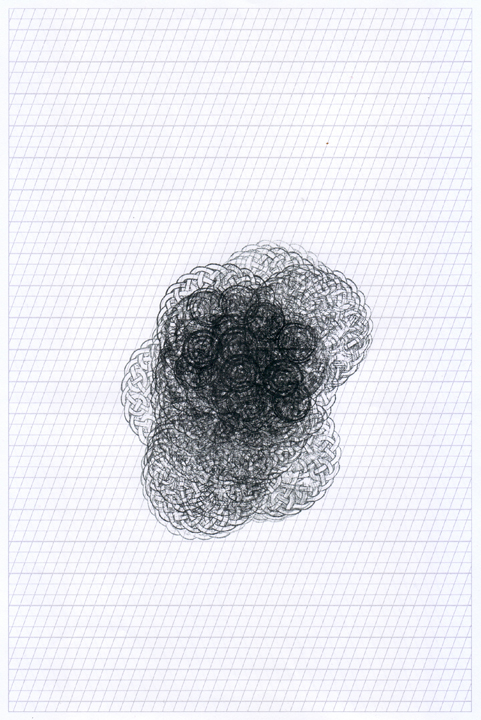 Paul McLean, "STATE 8"
Paul McLean, "STATE 8"
 2D,
2D,  B.J. SPOKE,
B.J. SPOKE,  co-op,
co-op,  occufest in
occufest in  art,
art,  art and food,
art and food,  drawing
drawing SAVE THE DATE: CO-OP at B.J. Spoke Gallery [9/5-30/2012][Opening Reception 9/9 from 6-8PM]
 Monday, July 30, 2012 at 03:36PM
Monday, July 30, 2012 at 03:36PM 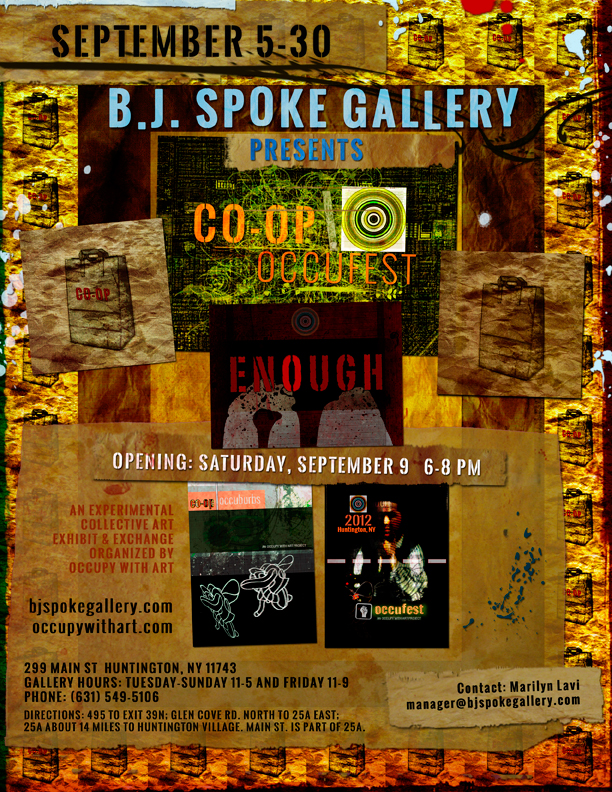
 BJ Spoke Gallery,
BJ Spoke Gallery,  Huntington,
Huntington,  co-op,
co-op,  occuburbs,
occuburbs,  occufest in
occufest in  exchanges,
exchanges,  exhibition
exhibition CO-OP/Occufest, OCCUPY: "Corporations Can't Cry at CAC"
 Friday, July 27, 2012 at 10:33AM
Friday, July 27, 2012 at 10:33AM 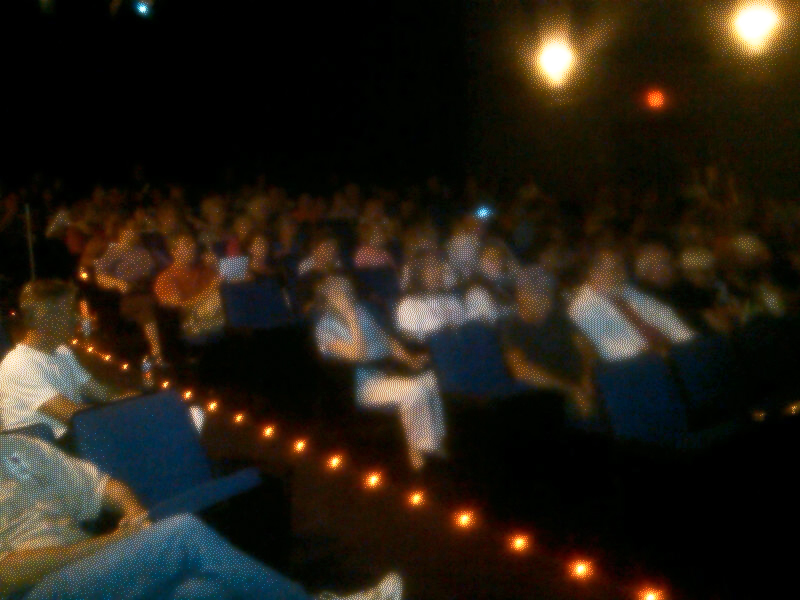 Crowd on hand for the screening of Liza Bear's "Corporations Can't Cry" at Cinema Arts Centre in Huntington, LI
Crowd on hand for the screening of Liza Bear's "Corporations Can't Cry" at Cinema Arts Centre in Huntington, LI
It was a special evening, thanks to the contributions of many people, and the hospitality of Cinema Arts Centre staff and admin. Chris Moylan, Occupy with Art co-organizer, did much of the heavy lifting in coordinating the events, which included the screening of "Corporations Can't Cry" in the big theater (which was nearly packed), a brief Q&A with filmmaker and longtime artist-activist-filmmaker-writer Liza Bear, followed by a mixer with food, free art, music and poetry, and a roster of activist organizers presenting information on their activities. Special thanks to Dylan, Charlotte, Brian, the Occupy Screenprinters, and all the other good people who made our first CO-OP/Occuburbs festival a memorable one.
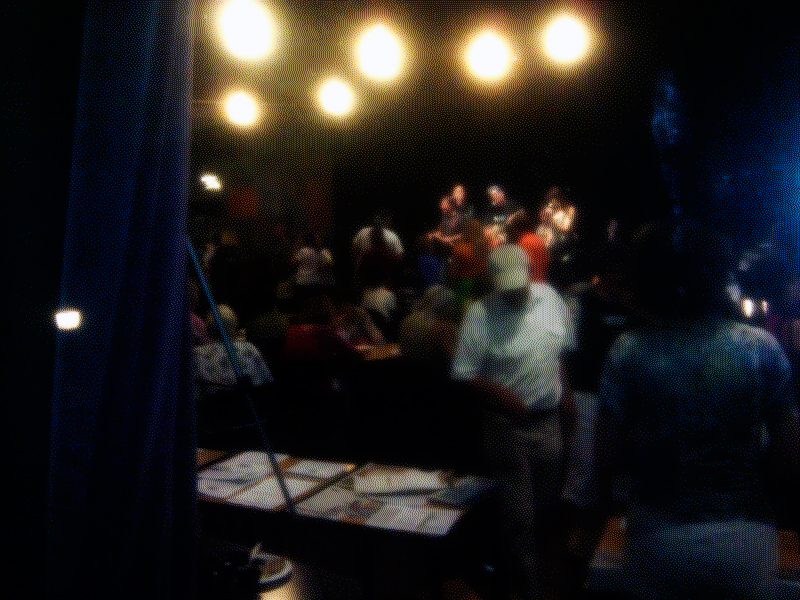 Occufest at the CAC Skyroom, post-screening.
Occufest at the CAC Skyroom, post-screening.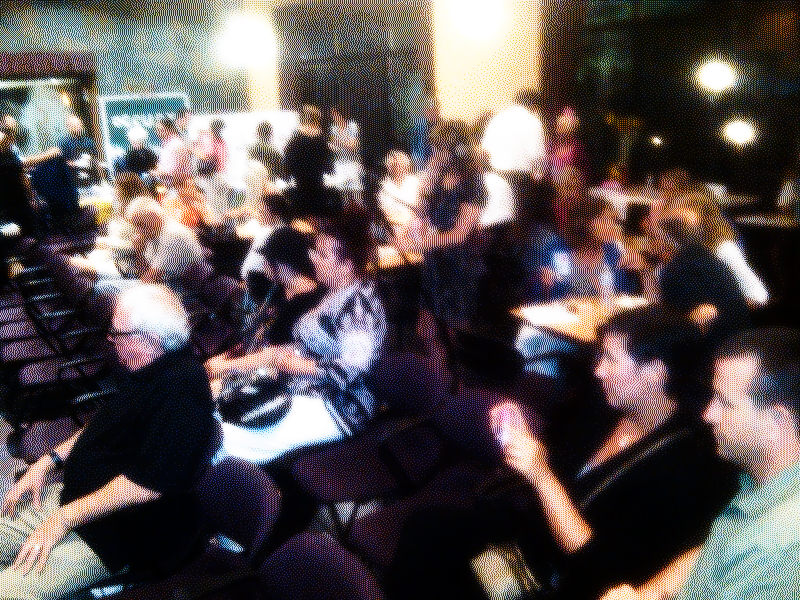 Another view of the Occufest audience, as the band plays on at CAC.
Another view of the Occufest audience, as the band plays on at CAC.
 Huntington,
Huntington,  cinema arts center,
cinema arts center,  co-op,
co-op,  occufest in
occufest in  activism,
activism,  community building,
community building,  festival
festival CO-OP/Occufest Flyer [b/w]
 Wednesday, July 18, 2012 at 08:13PM
Wednesday, July 18, 2012 at 08:13PM Free flyer download (8.5" x 11" 300dpi 1.9mb GS) HERE:
CO-OP/Occufest Flyer
 Tuesday, July 10, 2012 at 02:08PM
Tuesday, July 10, 2012 at 02:08PM Download a printable flyer (8.5"x11" 300dpi TIF 18.5mb) HERE.
 cinema arts center,
cinema arts center,  co-op,
co-op,  liza bear,
liza bear,  occufest,
occufest,  occupy with art in
occupy with art in  activism,
activism,  music,
music,  poetry,
poetry,  screening
screening CO-OP/Occuburbs Kick-off, with Films by Liza Bear, and More: Save the Date!
 Friday, June 22, 2012 at 10:33PM
Friday, June 22, 2012 at 10:33PM [Save the date: July 25, 2012]
Occupy with Art and Cinema Arts Center present a selection of short films by Liza Bear, + an evening of discussion, poetry, music and more -- to kick off CO-OP/Occuburbs in Huntington, Long Island.
Occupy: Corporations Can’t Cry

- Date:
- July 25, 2012
- Showtime
- Wednesday, July 25 at 7:30pm
Film / Discussion / Public Forum / Music / Poetry
Co-Presented by Occupy with Art and Cinema Arts Center
Join us for a lively and illuminating evening about Occupy Wall Street, featuring the films of Liza Béar (who has been at OWS since the first day of the occupation), music, poetry, and information about numerous Long Island activist organizations
- In Person: Filmmaker Liza Béar
- Music by Brian O’Haire
- Poetry by Christopher Moylan
$10 Members / $15 Public
(includes reception)
Tickets also available by calling 800-838-3006, or at the CAC Box Office
Scholarship Tickets are available for those unable to pay – Contact Charlotte Sky at 631-423-7610 x22
Since Day One, September 17, 2011, Liza Béar has filmed the modus operandi of Occupy Wall Street at Zuccotti Park and at other New York locales. Shot over a 7 month period, these 65 minidocs or situationist videos combine dialogue between–and with—an eclectic range of OWS participants, members of the community and the security forces. The style is a mixture of verité filmmaking and a more proactive, direct cinema approach. The aim has been to dispel mass media stereotyping and facile judgments. To be screened tonight: OWS Day 5: “Corporations Can’t Cry”; “Zuccotti Gets Surreal”; “Occupy the SEC: Enforce the Volcker Rule,” “Occupy the Courts: Foley Square Rally to End Corporate Personhood”; OWSJ29: “Murder By SpreadSheet; Health Care for the 99%”; OWS M28 “The Trap of Violence” and others.
Liza Béar is a New York-based writer, filmmaker and media activist. After arriving in New York in 1968, she cofounded the avant-garde artists’ magazine Avalanche 1970-1976 with Willoughby Sharp and was a co-producer of Communications Update, a public access artists’ tv show that also dealt with information politics. Her films have been shown at The Museum of Modern Art, the Edinburgh Film Festival, the Sao Paulo Biennial, and most recently at Torpedo Kunsthalle, Oslo, Macka Art Gallery, Istanbul and the ICA London. She is the author of “Beyond the Frame: Dialogues with World Filmmakers” (Praeger, 2007). Learn more at http://lizabearmakingbook.blogspot.com and http://communicationsupdate.blogspot.com
 cinema arts center,
cinema arts center,  co-op,
co-op,  liza bear,
liza bear,  occuburbs in
occuburbs in  discussion,
discussion,  music,
music,  poetry,
poetry,  screening
screening Occufest, Part II: Spread the News
 Monday, May 28, 2012 at 12:54PM
Monday, May 28, 2012 at 12:54PM 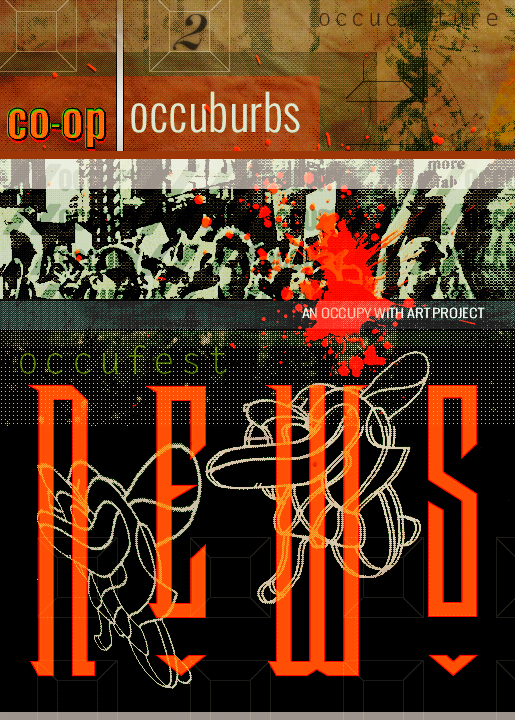
By Christopher Moylan
The contraction of Occupy Wall Street after the police stormed Liberty Square was to be expected, but with the return of longer days and warmer weather something peculiar happened. The movement remained in a dark chill while everyone else walked about in shorts and short sleeves complaining of the unnatural heat. Activists came back to the streets, the energy at demonstrations returned, yet little of this was reported in the news. For all anyone in the greater world knew, Occupy was dead.
To those who took part in the Million Hoodie March or the demonstration against police brutality, it was obvious that this media silence resulted from the collusion of forces more imposing than those of the editorial staff of Eyewitness News or, for that matter, The New York Times. The police mobilizations at each protest were too large, the disruptions of traffic and business the protesters caused were too widespread and dramatic, the arrests too violent and arbitrary for all this to be too trivial for comment. If thousands marching down Fifth Avenue on a Tuesday evening rush hour could not draw attention, then what would it take?
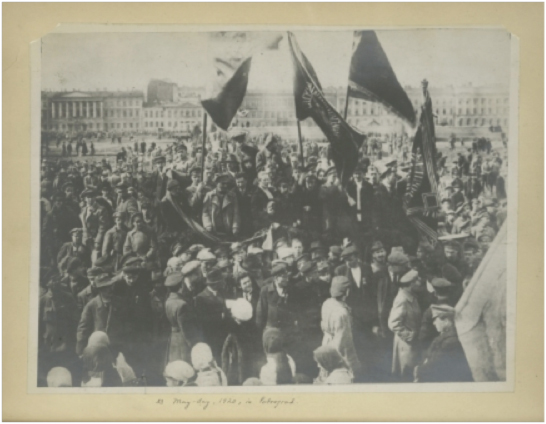
Perhaps this is the wrong question. For one thing, it is obvious what it would take to grab the attention of corporate news: mass arrests, violence, smashed shop windows and burning cars. If Occupy activists allow the police and their corporate/political sponsors to write the narrative that would discredit the movement, then the narrative would receive plenty of attention. That could happen, but let’s hope it doesn’t. So, isn’t this the question; if one could write an Occupy-related lead story for The Times, what would it say? Better yet, if it were possible to hold the attention of one disinterested person for a while—half an hour or an hour—what would one say? What would one hope to accomplish?
 co-op,
co-op,  occuburbs,
occuburbs,  occuculture,
occuculture,  occufest in
occufest in  occupations,
occupations,  texts
texts CO-OP Platform Text 3: Occufest [A Media Proposition]
 Friday, January 27, 2012 at 11:28AM
Friday, January 27, 2012 at 11:28AM 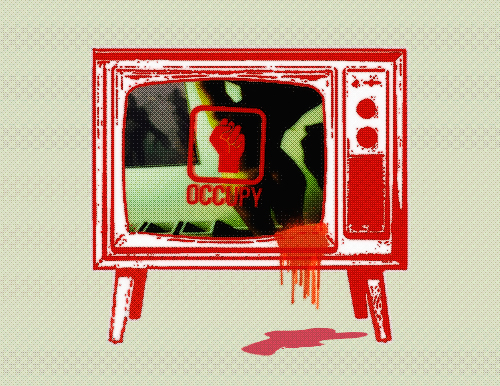
By Chris Moylan
Occupy Wall Street has been relentless in demonstrating the structural, legal and financial dimensions of a systematic and well-financed process to corrupt Congress, paralyze the executive branch, manipulate the courts, and weaken financial regulations to allow speculative banking and investment practices ruinous to millions and exorbitantly profitable to the few. This calling to account extends to environmental practices, war policy, food production and marketing; the list goes on.
It stands to reason that harm to art and culture has paralleled harm done to economic and political life. On a practical level, when millions lose their homes and their jobs the arts suffer in varying degrees along with other elements of a society. However, detecting changes in discourse, as opposed to changes in attendance or viewership or the like, is difficult and to a large extent requires the wisdom of hindsight. We can track accurately how many people are attending what kinds of movies, but it can take some time to determine what a given cluster of comedies or action movies says about the zeitgeist at given time. It can take time for the effects of social trauma to manifest themselves in fiction, movies, tv shows, not to mention more ambitious or serious undertakings in music, visual arts, poetry, and dance…
We can, however, identify some of the egregious forms of damage being inflicted on the public psyche right now, leaving the more subtle analysis of cultural artifacts to another time and context. In particular, the working poor and lower middle class people are subject to insult in the guise of entertainment and degradation in the guise of advertising. The Occupy Wall Street ambition to build a better world might include the task of defending and supporting the dignity of those who would inhabit. In particular this is something that artists and writers associated with OWS can do.
 chris moylan,
chris moylan,  co-op,
co-op,  occu-fest in
occu-fest in  anti-citizen tactics,
anti-citizen tactics,  media,
media,  propaganda,
propaganda,  television
television The Festival of Reason, the art of Common Sense
 Friday, December 30, 2011 at 08:46AM
Friday, December 30, 2011 at 08:46AM 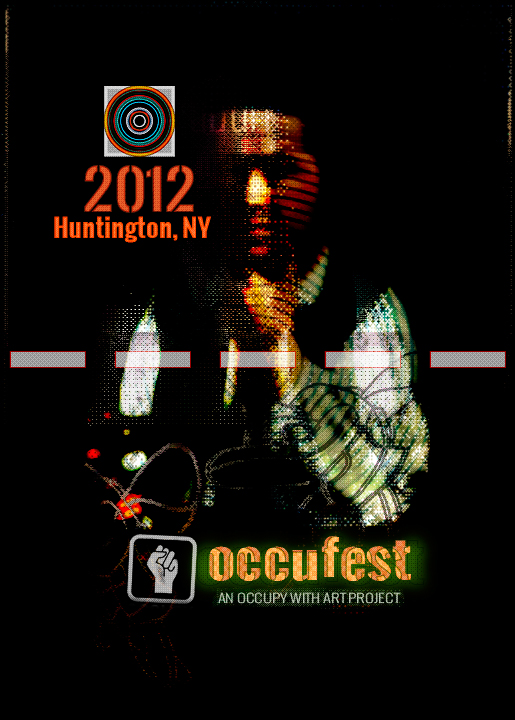 Graphic by Paul McLean
Graphic by Paul McLean
[NOTE: The following supporting text is the second part of a two-part essay by Chris Moylan for the OwA collab "CO-OP|occuburbs," slated for 2012 in Huntington, NY]; in this project we will be envisioning alternate art economies, inspired by the co-operative food and farm networks. Our point of origination as locus is the suburban (American) community, although we hope the applications can extend beyond that start-point.]
The Festival of Reason, the art of Common Sense
By Christopher Moylan
Plans are underway for an Occupy arts festival in the suburbs: Occufest in the Occuburbs. The initial contacts with different cultural organizations have been promising. People are enthusiastic; there are promises of space and other resources. Over and again, however, certain questions arise; what is this—the festival and Occupy Wall street-- about? What is the connection between Occupy Wall Street and the arts? What point would a festival make? What would it do?
One response is to turn such questions back on the person asking them; what does the Occupy movement mean to you? What kind of connection would you like to see between the arts and the Occupy movement? What point would you want such a festival to make? That kind of exchange tends to go only so far. People are asking for information and background, not for a daily dose of empowerment. To be fair, however, the Occupy movement has received a good deal of publicity and news attention; one would expect that most people would be familiar with the movement and what it is attempting to do. The discussion, then, probably has more to do with expectations based on personal history rather than with social policy or aesthetics.
The subtext of such questions seems to be something like this; my experience with politics has been disillusioning, will this be any different? And, my experience with art --as in paintings, sculpture, installations, art in galleries--has been disappointing, and puzzling so will this be any better?
By way of attempting a constructive answer, one consistent with an inclusive Occupy spirit, the questions can be reframed to emphasize the central position of the .99 in everything that the movement does and attempts to do.
So, preliminary to discussing what an Occufest might be like, one might ask what does cultural democracy look like? Under what conditions might art for the .99 emerge, and how would we recognize such work if we saw it?
 Huntington,
Huntington,  NY,
NY,  co-op,
co-op,  coop,
coop,  occuburbs,
occuburbs,  occufest,
occufest,  occupy with art in
occupy with art in  alternate economy,
alternate economy,  art and food
art and food 